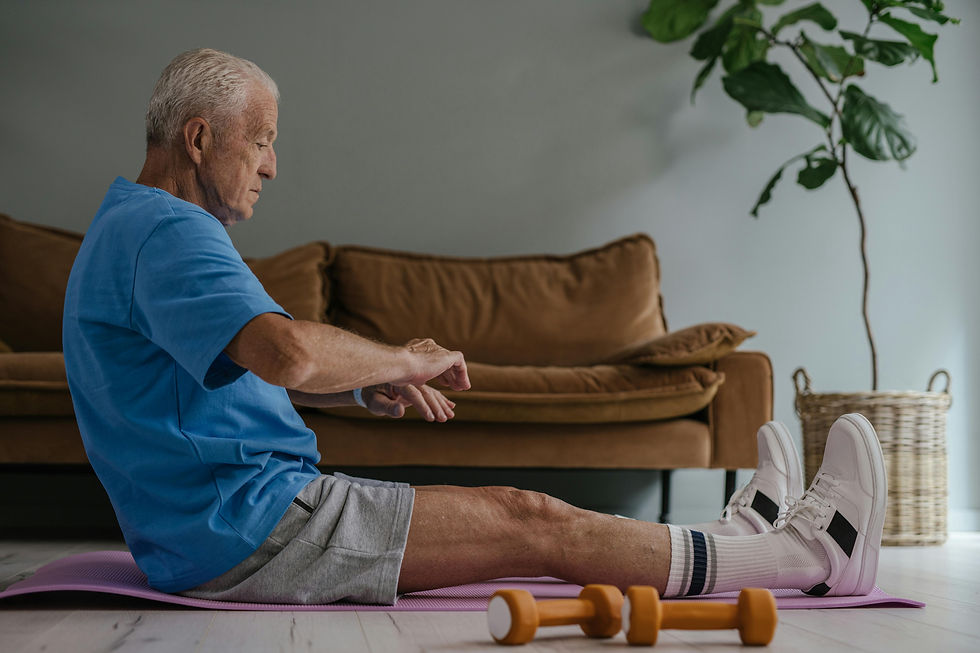Summer Mobility for Seniors: Safe At-Home Physical Therapy Tips
- Ashley Rodriguez
- Jul 21
- 4 min read

As the temperatures rise and the sun brightens our days, summer presents a fantastic opportunity for seniors to focus on mobility and wellness from the comfort of home. However, heat, humidity, and age-related limitations can make physical activity more challenging and sometimes risky, if not approached with proper care. That's why creating a safe and structured at-home physical therapy routine is essential for maintaining strength, balance, and independence during warmer months.
Whether you’re a senior yourself or a caregiver looking out for a loved one, here are practical and safe physical therapy tips to improve mobility at home this summer.
1. Prioritize Hydration and Climate Control
Before starting any exercise program, especially during summer, ensure that hydration is front and center. Seniors are more vulnerable to dehydration due to a decreased sense of thirst and the body’s diminished ability to conserve water.
Tips:
Drink water before, during, and after therapy sessions.
Exercise during the cooler parts of the day, early morning or evening.
Use fans or air conditioning to keep the workout area cool.
Wear breathable, light-colored clothing.
2. Start with Gentle Warm-Ups
Warming up prepares muscles and joints for movement, reduces stiffness, and lowers the risk of injury.
Simple warm-up exercises include:
Marching in place for 1–2 minutes.
Shoulder rolls and arm circles.
Gentle neck and ankle rotations.
Warm-ups should take about 5 minutes and be performed at a comfortable pace. If dizziness or shortness of breath occurs, take a break and consult a healthcare professional.
3. Focus on Core Mobility Exercises
Mobility exercises help improve range of motion, reduce pain, and support better balance and coordination. These are especially beneficial for seniors who are recovering from surgery, illness, or simply trying to stay active and independent.
Recommended exercises:
Seated leg extensions: While sitting in a sturdy chair, extend one leg at a time and hold for a few seconds to strengthen the quadriceps.
Heel-to-toe walk: Practicing walking in a straight line, placing one foot directly in front of the other, improves balance.
Chair squats: Standing and sitting from a chair builds lower body strength safely.
Standing hip abductions: While holding onto a countertop or sturdy surface, slowly lift one leg to the side and return. Repeat on both sides.
4. Incorporate Stretching to Improve Flexibility
Stretching after exercise can reduce muscle soreness and improve flexibility, which helps prevent falls and enhances daily functioning.
Targeted stretches:
Hamstring stretches (seated or standing).
Calf stretches against the wall.
Shoulder stretches using a towel or resistance band.
Back stretches while lying down or seated.
Hold each stretch for 15–30 seconds and avoid bouncing or forcing any position.
5. Use Assistive Devices When Needed
At-home physical therapy can be enhanced with the proper use of assistive devices to support stability and prevent falls. These may include:
Walkers or canes
Stability balls
Resistance bands
Non-slip mats or footwear
Chairs with arms for support during exercises
Ensure that any equipment used is in good condition and that floors are cleared of tripping hazards.
6. Practice Breathing and Relaxation Techniques
Deep breathing exercises and gentle relaxation techniques can support overall wellness and reduce stress, especially for seniors dealing with chronic conditions or limited mobility.
Suggestions:
Box breathing: Inhale for 4 counts, hold for 4, exhale for 4, and pause for 4.
Seated yoga or tai chi-inspired movements can improve mental focus, coordination, and body awareness.
7. Listen to the Body and Know the Limits
One of the most important aspects of a safe at-home physical therapy routine is recognizing when to rest. Seniors should never push through pain, dizziness, or fatigue.
Red flags to stop and consult a healthcare provider:
Chest pain or tightness
Sudden shortness of breath
Extreme fatigue
Loss of balance or coordination
Muscle cramps or joint pain that doesn’t improve with rest
8. Stay Consistent, but Add Variety
Creating a routine can help seniors stay on track, but variety is key to engaging different muscle groups and avoiding monotony.
Weekly routine idea:
Monday/Thursday – Strength training (chair exercises, leg lifts)
Tuesday/Friday – Balance and flexibility (yoga, tai chi)
Wednesday – Light cardio (walking inside the home or outdoors with supervision)
Saturday/Sunday – Rest or light stretching
9. Engage with a Licensed In-Home Physical Therapist
While self-guided exercises are beneficial, working with a licensed physical therapist brings expertise, personalized planning, and safety oversight. They can tailor exercises to individual medical conditions like arthritis, osteoporosis, stroke recovery, or joint replacements. They can also identify subtle signs of mobility decline that may not be apparent to caregivers or seniors themselves.
If your loved one prefers to stay at home but needs professional guidance, consider at-home therapy services that focus on individualized and compassionate care.
Take the First Step Toward Better Mobility This Summer
At-home physical therapy offers seniors the ability to stay active, mobile, and independent, even in the summer heat. With safe practices, consistent routines, and professional guidance, aging adults can continue doing the things they love.
Looking for compassionate, expert-led in-home physical therapy in New Jersey?
Coastal Home Rehab provides personalized, one-on-one therapy sessions right in the comfort of your home. Whether you're recovering from surgery or simply want to stay strong and steady, our licensed professionals are here to help.
Contact us to schedule a consultation today!




Comments